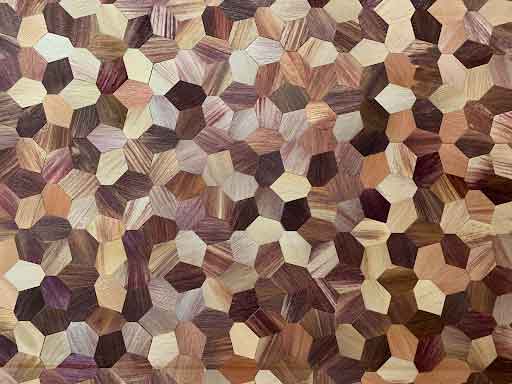Wood veneer has been a trusted choice in woodworking for many years, blending both beauty and practicality. With technological advances and craftsmanship, wood veneer has found its way into various industries, from furniture parts to architecture and interior design. Its versatility and aesthetic appeal make it a preferred choice for those looking to bring the natural beauty of wood into their projects like our veneered hpl consoles while also keeping efficiency in mind.
What is Wood Veneer?
In essence, wood veneer is a thin layer of wood derived from the outer growth rings of trees. Historically, its use can be traced back to ancient civilizations, where it was prized for its ability to convey the beauty of wood without the need for thicker cuts. As eras passed, veneering techniques adapted to cater to contemporary demands and diverse applications.
Differentiating Veneer Wood from Solid Wood
It’s common for many to mistake solid wood for veneer wood and vice versa, primarily because of their comparable appearances and textures. Indeed, understanding what is veneer wood can help clarify this common confusion.
Qualities of Solid Wood:
Durability: Solid wood stands the test of time. Its inherent strength ensures longevity, often enduring for decades, especially when taken care of appropriately.
Versatility: This material is adaptable by nature. Solid wood can be reshaped, resized, and refinished multiple times, allowing for various alterations over its lifespan.
Natural Look: Solid wood boasts an undiluted charm. It presents a genuine wood grain pattern and a rich texture that many find appealing.
Heft and Weight: Due to its mass, solid wood exudes a sense of weightiness and substance, often making furniture and fixtures feel sturdier and more grounded.
Qualities of Veneer Wood:
Flexibility: Veneer wood breaks the mold. Thanks to its thinness, it can be bent, curved, and contoured in manners that solid wood would resist, paving the way for intricate designs.
Resource Efficiency: Veneer champions conservation. By using just a fraction of the wood to cover the same surface area, it promotes eco-friendly and sustainable woodworking practices.
Consistency: Uniformity is critical with veneer. It offers consistent patterns and hues, especially vital for large-scale projects where uniformity can determine the final appearance.
Cost-Effectiveness: Veneer often comes with a smaller price tag, making it a more affordable option while still capturing the allure of natural wood.
While solid wood emanates an age-old aura of sturdiness and authenticity, veneer wood capitalizes on its adaptability and eco-efficiency. Each has its unique advantages, with the optimal choice often being dictated by a project’s specific needs and objectives.
The Craftsmanship Behind Wood Veneer
Veneering is a meticulous process that requires precision, patience, and an appreciation for the subtleties of wood. The transformative journey from a solid log to a sheet of veneer involves multiple steps, each crucial to ensuring the highest quality output.
- Log Selection: A high-quality log is chosen, often based on factors like its grain, texture, and overall health. The right log ensures that the resulting veneer carries a desirable appearance and strength.
- Slicing: Once selected, the log undergoes a precise slicing process. This step determines the veneer’s thickness, affecting its flexibility and application.
- Drying: After slicing, the wood slices are dried. Proper drying is pivotal as it stabilizes the wood, reducing its propensity to warp or crack in fluctuating conditions.
- Treatment: Post drying, the slices receive treatments that enhance their durability, appearance, and resistance to external factors like moisture and pests.
With each stage in the creation process, the wood is transformed, enhanced, and primed for its eventual use in various applications, from furniture to architectural design.
Marquetry and Inlay: The Art of Decorative Veneering
In the decorative sphere of veneer, marquetry and inlay stand out as traditional techniques that amplify its aesthetic richness. Marquetry crafts designs by assembling various veneer slices, creating captivating patterns or depictions.
In contrast, inlay integrates veneer pieces directly into surfaces, resulting in designs where the veneer merges seamlessly with the base material. Though distinct in application, both techniques highlight the veneer’s versatility and its power to magnify the inherent magnificence of wood.
Types of Veneer and Their Applications
Wood veneers have revolutionized the way we perceive and utilize timber in design. Their remarkable versatility extends across various domains, from furniture crafting to architectural innovations, ensuring their influence is far-reaching.
Popular Wood Veneer Species
When it comes to veneers, the spectrum of available wood species is vast. Common choices like Walnut and Oak are favored for their familiar appearance and versatility, particularly in domestic settings. On the other end, exotic veneers offer distinctive textures and colors. Every veneer type, whether commonplace or exotic, carries its own narrative and character, deeply influencing the final product’s appeal.
The Multifaceted Realm of Veneered Wood
Veneered wood’s adaptability is one of its crowning glories. Whether serving a functional purpose or elevating aesthetic appeal, its presence is felt in numerous applications:
- Furniture: Ranging from the grandeur of boardroom tables to the intimacy of bedroom furniture, veneer’s touch is unmistakable.
- Architecture: Veneers are employed in features like wall panels, ceiling designs, and cabinetry. They offer structural benefits and breathe life into spaces with their refined appearance.
- Daily Products: Everyday items, such as dashboards, desktops, and ornate decorative artifacts, come alive with the application of veneer.
- Musical Instruments: Many musical instruments, especially premium guitars and pianos, use veneer to enhance resonance and achieve a superior aesthetic finish.
- Luxury Items: High-end products, including designer handbags or limited-edition collectibles, often sport veneer accents for exclusivity.
Incorporating veneer in diverse arenas underscores its unparalleled adaptability. As designers and craftsmen continue to explore its potential, veneered wood remains a testament to the perfect blend of nature’s bounty and human ingenuity.
Advantages and Limitations of Veneer Wood
Understanding veneer wood in its entirety involves recognizing both its compelling advantages and certain limitations. As with any material, veneer wood has its set of characteristics that can serve as strengths in some scenarios and potential challenges in others.
Advantages of Veneered Wood
Veneered wood has carved a niche for itself in woodworking and design for myriad reasons:
Sustainability
The very essence of veneering is about maximizing the utility of wood. Transformed into veneer, a single log yields far more coverage than it would if it were processed into solid wood. This ensures the efficient use of timber resources and aligns with global efforts towards responsible forestry and conservation. With deforestation being a critical concern, veneered wood presents an eco-friendly alternative that decreases the demand on our forests.
Cost-Effectiveness
One of the perennial appeals of wood is its timeless beauty and rich texture. While premium wood species can drive up the price of solid wood, veneered wood serves as a more affordable option. By offering the same visual appeal and tactile sensation as solid wood but at a fraction of the cost, it democratizes access to high-quality wood finishes. Whether it’s for home furnishings or office interiors, veneered wood ensures that budget constraints don’t compromise aesthetic aspirations.
Versatility
Veneered wood is not just about cost savings or sustainability; its adaptability is a defining feature. It can be molded, shaped, and integrated into various designs and products, allowing designers and homeowners greater creativity. Whether it’s intricate patterns, modern straight lines, or customized inlays, the versatility of veneered wood enables unique and personalized design expressions.
Limitations and Preventative Measures
While veneered wood offers a suite of benefits, it’s crucial to recognize and navigate its inherent limitations. By understanding these challenges, one can employ strategies to extend the lifespan and beauty of veneered surfaces.
Maintenance Needs
Unlike other finishes, veneer surfaces require regular attention to retain their sheen. This encompasses everything from the simple act of dusting to ensuring spills are promptly addressed. Using gentle cleaning agents, instead of harsh chemicals, can also prolong the life and look of veneered surfaces.
Potential Vulnerabilities
The nature of veneer, given its thin profile, inherently makes it more susceptible to certain damages. Impacts, scratches, or prolonged exposure to moisture can mar its appearance. However, many of these vulnerabilities can be minimized with foresight.
Strategic placement of veneered items, such as keeping them away from high-traffic areas, direct sunlight, or moisture-prone zones, can reduce potential harm. Similarly, using protective measures, like coasters or table pads, can prevent direct damage, and maintaining a stable environment — one free from extreme temperature or humidity fluctuations — ensures the veneer remains in optimal condition.
In weighing the benefits and challenges of veneer wood, it becomes evident that with proper care and understanding, the strengths of veneered wood can far surpass its limitations. Its sustainable nature and affordability make it a choice that resonates with modern-day needs, ensuring its continued popularity in various applications.

